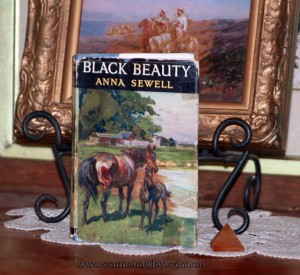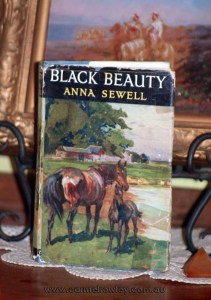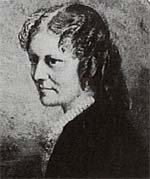HAPPY BIRTHDAY – ANNA SEWELL
Today is Anna Sewell’s birthday and as the horse loving community fondly remembers her special day I can’t help wondering about the generations of horse loving children who have never read or loved Black Beauty.
I don’t remember the exact time I received my first copy of Black Beauty, although I do remember the profound effect it had on me when I realised how heartless and cruel people could be to horses.
As I grew up, married and eventually bred horses of my own that a niggling recollection of how you should treat horses was always there in the back of my mind after reading Black Beauty. I’ve never forgotten the whipping of Beauty, and his falling to his knees …
It’s a long time since I opened Anna’s book but I’ve always abhorred cruel, unnecessary and habitual ways of training horses. Man can be ruthless but when it comes to the cruel treatment of a prey animal with a well-developed flight response. It leaves me wondering how people who profess to love horses can behave in such a way.
“It is good people who make good places.”
~Anna Sewell, Black Beauty
The impulse to write came upon me over a decade ago and this raised eyebrows as I worked for years on my idea and ideals. Although I cannot in any way compare myself to Anna I understand her concerns and pursue (and continue to do so) in my own way, a means to highlight my personal fears and support for an the animal I truly love.
It’s hard to imagine that Black Beauty was published in 1877 because even now this wonderful classic resonates to all who own, love and work with horses. As stated below, Anna Sewell said “a special aim [was] to induce kindness, sympathy, and an understanding treatment of horses.”
ANNA SEWELL
From Wikipedia, the free encyclopedia
http://en.wikipedia.org/wiki/Anna_Sewell
Anna Sewell, Born 30 March 1820 – Died 25 April 1878 (aged 58) was an English novelist, best known as the author of the classic novel Black Beauty.
Sewell was born in Great Yarmouth, Norfolk, England, into a devoutly Quaker family. Her father was Isaac Phillip Sewell (1793–1879), and her mother, Mary Wright Sewell (1798–1884) was a successful author of children’s books. She had one sibling; a younger brother named Philip and was largely educated at home.
When Anna was twelve, the family moved to Stoke Newington where she attended school for the first time. Two years later, however, she slipped while walking home from school and severely injured both of her ankles. Her father took a job in Brighton in 1836, in the hope that the climate there would help to cure her. Despite this, and most likely because of mistreatment of her injury, for the rest of her life Anna was unable to stand without a crutch or to walk for any length of time. For greater mobility, she frequently used horse-drawn carriages, which contributed to her love of horses and concern for the humane treatment of animals.
At about this time, both Anna and her mother left the Society of Friends to join the Church of England, though both remained active in evangelical circles. Her mother expressed her religious faith most noticeably by authoring a series of evangelical children’s books, which Anna helped to edit, though all the Sewells, and Mary Sewell’s family, the Wrights, engaged in many other good works.
While seeking to improve her health in Europe, Sewell encountered various writers, artists, and philosophers, to which her previous background had not exposed her.
Sewell’s only published work was Black Beauty, written during 1871 to 1877, after she had moved to Old Catton, a village outside the city of Norwich in Norfolk. During this time her health was declining. She was often so weak that she was confined to her bed and writing was a challenge. She dictated the text to her mother and from 1876 began to write on slips of paper which her mother then transcribed.
Sewell sold the novel to local publisher Jarrolds on 24 November 1877, when she was 57 years of age. Although it is now considered a children’s classic, she originally wrote it for those who worked with horses. She said “a special aim [was] to induce kindness, sympathy, and an understanding treatment of horses”
Sewell died on 25 April 1878 of hepatitis or tuberculosis, five months after her book was published, living long enough to see its initial success. She was buried on 30 April 1878 in the Quaker burial-ground at Lammas near Buxton, Norfolk, not far from Norwich, where a wall plaque now marks her resting place.



Leave a Reply